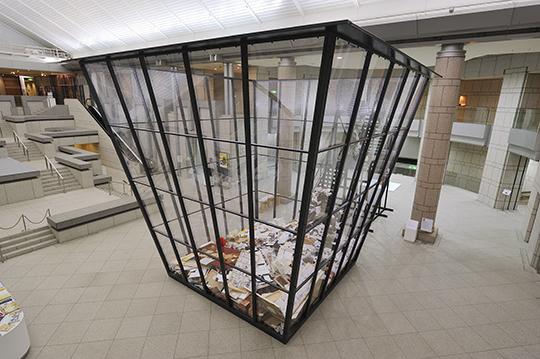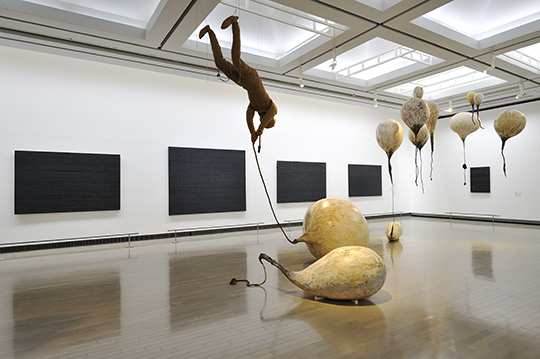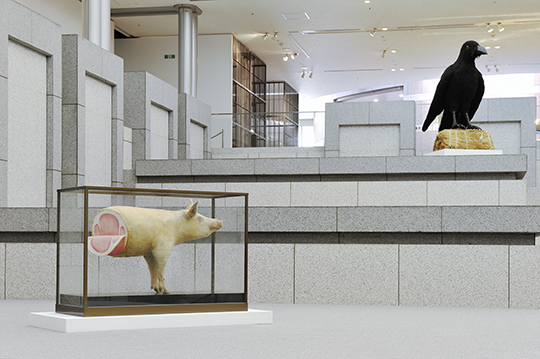YOKOHAMA TRIENNALE 2014 ART FAHRENHEIT 451: SAILING INTO THE SEA OF OBLIVION
| July 30, 2015 | Post In LEAP 29

Installation view, 2014
PHOTO: Tanaka Yuichiro
Courtesy of Organizing Committee for Yokohama Triennale
When the Taipei Biennial and Shanghai Biennale announced that their present editions would be curated, respectively, by Nicolas Bourriaud and Anselm Franke, there were strong echoes of theoretical discourse and cultural internationalism shared between the two regions. Further east on the Pacific rim, the Yokohama Triennale boldly appointed artist Yasumasa Morimura artistic directer (the Triennale once invited architect Arata Isozaki to be artistic director of its second edition, but ultimately found his plan too ambitious). Unlike most biennials, which focus on a core theoretical issue, “ART Fahrenheit 451: Sailing into the sea of oblivion” is a cruel and poetic theme. It borrows the title of Ray Bradbury’s science fiction novel Fahrenheit 451, which depicts the altered duties of firemen in a dystopian future society—burning books. The other half of the title pinpoints oblivion as a key concept for the exhibition. Morimura suggests that “Human beings have discarded (=forgotten) an unimaginable quantity of information (and things) up until this moment. A far greater quantity of information (and things) must have been discarded before even being held in memory … in addition to memories that have probably been erased and banned by censorship and authorities.” What is forgotten here refers not only to the valuable information hidden or overlooked through rapid social development, but also recalls an “interior Asia” in modern art that we have yet to fully experience.
Influenced by Yukio Mishima, Yasumasa Morimura produces the exhibition in the form of a novel. “Introduction: What is in the Center of the World?” opens with a thought-provoking piece by the once-controversial artist Michael Landy, of YBA fame. His Art Bin introduces the whole story with an argument for the materiality and value of art. In opposition to the concept-driven contemporary art world, Morimura launches an alarming fable before the real exhibition even begins. Entering “Chapter 1: Listening to Silence and Whispers,” the visitor immediately understands the curator’s intent to bring his audience back to a rational and calm modernist art world. Kazimir Malevich’s Suprematist Drawing and John Cage’s 4’33” sit quietly in the first gallery, followed by abstract works from the American Josh Smith, the Canadian Agnes Martin, and the Spanish Karmelo Bermejo. At the end of the passage, human and feline sounds emitted from a dark room break the silence of this abstraction; this is Marcel Broodthaers’s Interview with a Cat, a little-known work from the 1970s by the Belgian conceptual artist in which his close friend René Magritte repeats the phrase “This is a pipe; this is not a pipe” to a cat. Magritte’s photographs are also displayed alongside the sound piece (1104b33). In his Poetics, Aristotle defines comedy as an activity that mimics the funny nature of the buffoon, making people laugh and prevent- ing them from feeling pain (1449a32-36). That is to say, at least for the audience, comedy must display moderation to avoid feeling or heading towards evil and suffering.

Foreground: Fukuoka Michio, Why did I ever fly?, 1965-66
PHOTO: Tanaka Yuichiro
Courtesy of Organizing Committee for Yokohama Triennale
Just when viewers think they can continue along with abstract and conceptual art in peace, a second chapter ensues. “Chapter 2: Encountering a Drifting Classroom” shows classes at Kamagasaki Free Art University (Kama Gei), a program offering lesture and workshop in the Airin district of Osaka. The neighborhood is
one of Japan’s few remaining slums, home mostly to day laborers who contributed to the postwar economic miracle. Morimura himself once taught there. This is a story about forgetting, revealing sides of a forgotten story. In this grand narrative, Morimura breaks the temporal barrier between modern art and contemporary practice, enabling a shift between art and reality.
Zhang Enli, the only participating artist from China, is included in “Chapter 4: Laboring in Solitude, Wrestling with the World,” which focuses mainly on Japanese artists. Michio Fukuoka’s Why did I ever fly? (1965-1966) takes center stage with a man floating in midair and a ball holding him down. Yuko Mohri, born in the 1980s, is a new rising star on the international art scene; her work can also be seen at the Sapporo International Art Festival. Basing her work on an American composer who died in 2012, she creates a romantic world that transcends time and space in her I/O―Chamber of a musical composer. Masunobu Yoshimura, the avant-garde artist of the 1960s, has a piece in the lobby titled Pig; pig’ Lib;. Morimura has noted that he is not particularly familiar with Asian artists outside of Japan, and few are presented here. However, the exhibition does offer an excellent perspective on the global avant-garde of the 1960s and 70s, poetically linking it to the present condition in a bold gesture rare among biennials today. Morimura’s most prolific period, 1970 to 1990 (corresponding to the Cultural Revolution and Reform and Opening in China), marked the pursuit of a global dialogue with hybrid and inclusive artistic language not confined to traditional or regional motifs. When it comes to the study of modern art, Japan was once far ahead of the rest of Asia.

Background: Yoshimura Masunobu, Oh- Garasu, 1969
No conceptual baggage is necessary to view this exhibition. Like reading a novel, the viewer is free to linger in front of certain works or jump to another chapter as the plot moves up and down. Morimura produces the exhibition with his faith in art over theoretical research, and his philosophy seems trustworthy.
Out of four collateral exhibitions, three take on Asian themes and contexts, including those of Quanzhou, China, and Gwangju, South Korea, building on Yokohama’s cultural policy as the Culture City of East Asia 2014. Two programs in “Chapter 10: Days After Deluge,” located at the second exhibition hall at Shinko Pier, feature projects from Sapporo International Art Festival and the Fukuoka Asian Art Triennale. The latter begins with images of the ocean between Busan and Fukuoka captured by Korean artist Kim Seong-youn and ends with Vietnamese artist Dinh Q. Le’s animation of a U.S. Army helicopter falling into the sea. This, perhaps, is the most powerful scene: emerging from a dark space having seen a series of films about the sea, the blue sea and an open pier are waiting at the exit.

